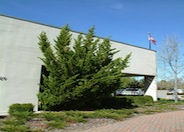
Common name:Hollywood Twisted Juniper
Botanical name:Juniperus chinensis 'Kaizuka'
The dark green foliage on the branches of this Juniper start in a narrow cone shape when young but open up gracefully when older. Its twisted looking branches resemble flames. It may grow 15' tall in 15 years. Over time, the branches may lean to one side. Junipers are highly combustible plants.
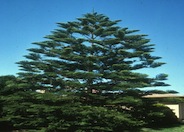
Common name:Norfolk Island Pine, Star Pine
Botanical name:Araucaria heterophylla
This very large tree will grow to about 100' tall and 60' wide with narrow, sharp leaves that are a deep, dark green. It is a popular Christmas tree in Hawaii. It is a good indoor plant with sunny exposures.

Common name:New Zealand Flax, Purple
Botanical name:Phormium tenax 'Atropurpureum'
Phormium tenax 'Atropurpureum' is an evergreen perennial. Big, dramatic plant composed of many swordlike, stiffly vertical leaves can reach 5' tall. Leaves are purple red. Flowers stems reach high above leaves, bearing clusters of 1"-2" blossoms in dark red.

Common name:Waxleaf Privet
Botanical name:Ligustrum japonicum 'Texanum'
This dense evergreen shrub of an upright habit is capable of growing as a shrub or small tree. Its dark green, leathery leaves are opposite those of a simple evergreen plant.

Common name:Frades or Compact Escallonia
Botanical name:Escallonia 'Frades'
The 'Frades' is an evergreen shrub that grows to 6'-8' tall and wide. It is valued for its glossy foliage and clusters of pink flowers. The heaviest bloom period is during spring and fall, with some flowers all year. The Escallonias grow best in sun to part shade, but will tolerate mostly shade if necessary. These plants usually need little or no summer watering. This is the most tolerant of poor drainage of all Escallonia varieties. -Monterey Bay Nursery
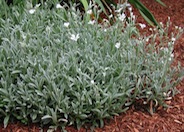
Common name:Snow-In-Summer
Botanical name:Cerastium tomentosum
Masses of snow white flowers highlight this plant during the early summer season.
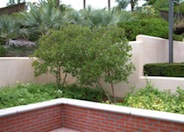
Common name:Strawberry Guava
Botanical name:Psidium cattleianum
This shrub will reach 12' tall and has medium sized, glossy green leaves with white flowers that bloom in the summer.

Common name:Lily of the Nile
Botanical name:Agapanthus praecox ssp. orientalis
This evergreen groundcover/shrub will grow about 3' tall and has large green leaves with blue flowers ( there is also a white variety) that bloom in spring and summer. It will grow in all soils but prefers loam soil.
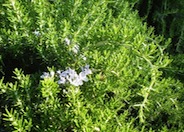
Common name:Rosemary
Botanical name:Rosmarinus officinalis
Rosemary is hardy in full sun areas where winter temperatures do not drop below 10 degrees F. They can be grown in a clay pot with well-drained, porous soil in bright indoor light, and will also flourish on the backporch in spring, summer and fall. Its beautiful, slowly trailing stems and shiny slender leaves are perfect for showing off the small, light blue flowers that blossom in the summer. -Holland WIldflower Farm
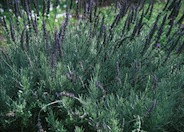
Common name:Goodwin Creek Grey Lavender
Botanical name:Lavandula 'Goodwin Creek Grey'
Lavandula 'Goodwin Creek Gray' is an evergreen shrub. This dense foliaged plant grows to 2.5'-3' high and 3'-4' wide, with silvery leaves that are toothed at the tips. Deep violet-blue flowers bloom from spring to late fall.

Common name:Blackwood Acacia, Black Acacia
Botanical name:Acacia melanoxylon
Blackwood Acacia is a fast growing tree reaching 30'-50' with 20'-30' spread. It has white flowers that are noticeable from March through May. It can work as a windbreak and has wonderful biomass value. Its leaves are dark green and narrow, with flowers that can be creamy to straw-colored, growing in short clusters and appearing in March or April.

Common name:Tree Roses
Botanical name:Rosa Tree varieties
Tree roses are actually shrubs that have been grafted or grown in a way that looks like a tree, ie with a trunk. Tree roses can be floribundas, hybrid teas, or grandifloras. They are typically used as specimen plants. Make sure the plant is tied to a stake in case of strong winds.
Sustainable Landscaping Fundamentals
Sustainable landscaping is a term coined to mean sensible landscape practices that work within the limits of the Eco-system. This means within the limits of your local rainfall, soil conditions and sun patterns.
Click in the green box for more information
| Designer: | Garden Lace |
Photographer: GardenSoft |
Soils and Compost:
Practice grass-cycling by leaving short grass clippings on lawns after mowing, so that nutrients and organic matter are returned to the soil.
Integrated Pest Management:
Drip and other smart irrigation delivers water directly to roots, allowing no excess water for weeds.
